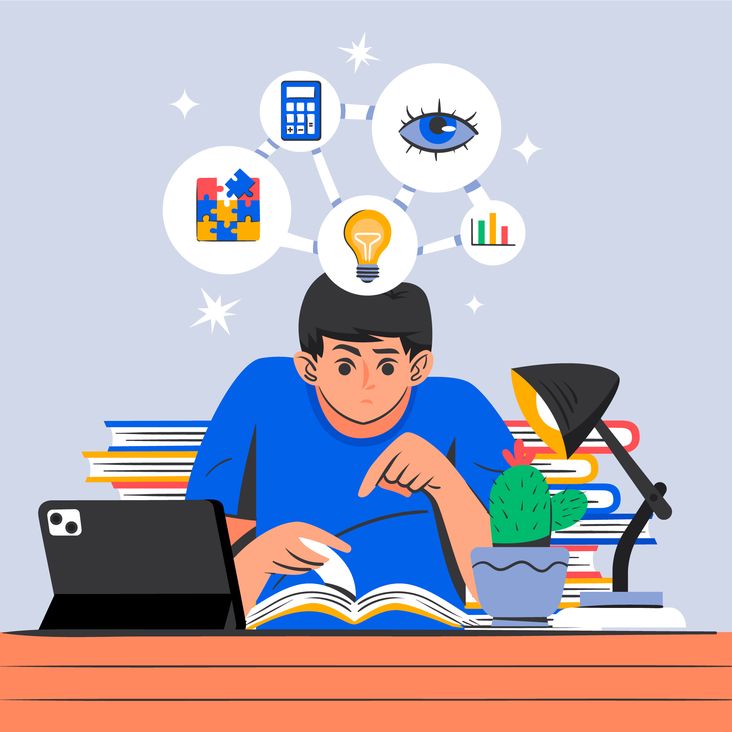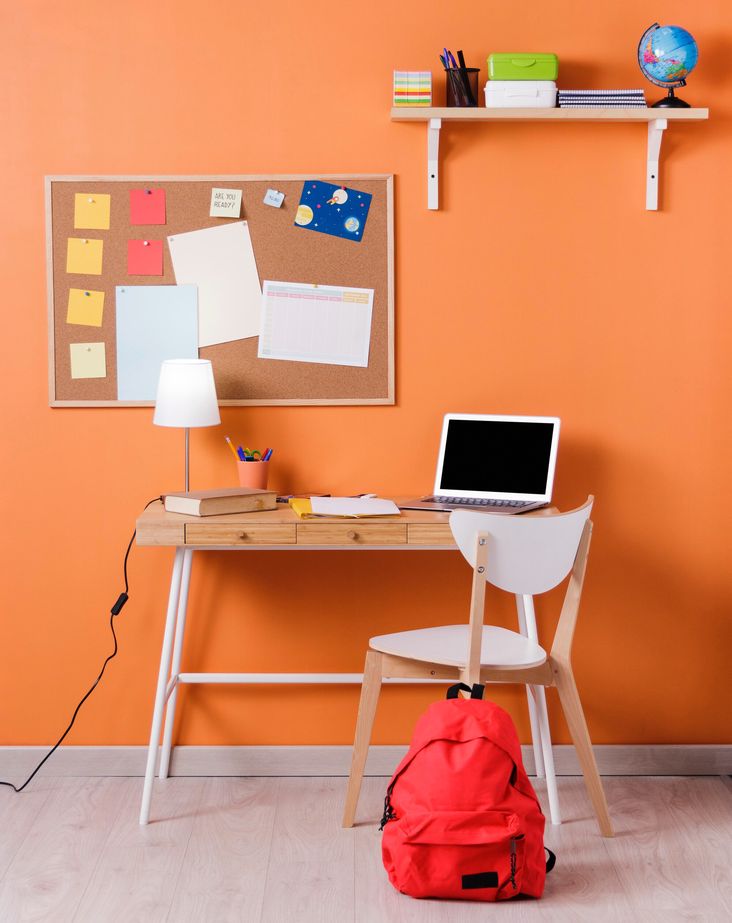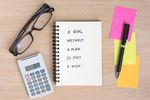Study Techniques for Effective Learning
Apr 1, 2025 by Vreny Blanco · 17 min read · Focus, Time Management

Effective learning is a crucial skill that not only boosts cognitive abilities but also helps preserve memory as we age. However, it involves more than just reading a book or attending a class. It requires creating the right environment, managing time well, choosing suitable learning methods, and considering emotional and physical factors. These elements directly impact our ability to focus and retain information.
In this blog post, you’ll discover how to set up your study space, use effective techniques, and maximize your time and energy.
Key Factors for Effective Learning
To achieve meaningful and lasting learning, it’s important to focus on key factors that affect our concentration and information retention. These include the study environment, available materials, and time management.
A comfortable, organized, and distraction-free study environment promotes concentration and allows for sustained attention. Having the right materials—such as books, notes, digital devices, and writing tools—facilitates learning by preventing interruptions and enabling a smooth workflow.
Effective time management is crucial for evenly distributing study sessions, setting realistic goals, and avoiding cognitive overload. Planning ahead and taking regular breaks helps maintain motivation and prevent burnout.
Finally, cultivating a genuine interest in the subject is vital for smooth and meaningful learning. When we are curious and intrinsically motivated, our minds become more receptive, leading to deeper understanding and long-term retention.
Sources of Information
Oral Information: Classes and Seminars
When learning through lectures, seminars, or classes, we often can’t choose the time and place. However, preparing in advance can enhance understanding and help assimilate the content more effectively.
Written Information: Books and Digital Resources
With written materials like books and study guides, we usually have the flexibility to choose our study location. The same applies to digital resources, which only require a computer, phone, or laptop.
In these cases, you can opt for the stimulating environment of a library, a coffee shop, a park, or the comfort of your own home.
Study Location
Before starting a study session, ensure you have all necessary materials, such as a notepad, pencils, colored markers, highlighters, eraser, corrector, whiteboard, laptop, and books. A suitable desk and chair are essential, along with a water bottle to stay hydrated, and a clock to track your study time.

Organize Your Study Space for Better Learning
To maintain optimal alertness while studying, consider these tips:
- Keep your workspace clean and organized.
- Use a comfortable chair that isn’t too relaxing.
- Ensure good ventilation and fresh air flow.
- Maintain a room temperature slightly below comfort to prevent drowsiness.
- Ensure adequate lighting.
- Establish a clear study routine.
- Carefully regulate work and rest times.
Additional Tip on Lighting
If you study in poorly lit areas, consider a small portable reading lamp. These lamps are easy to transport and can be placed directly on your book or study material. I personally use a lamp from Gritin, which is very handy for traveling or reading on the couch at home.
Additional Tip for Springtime
If you’re allergic to dust or pollen (like me) and study from home, consider getting an air purifier. I use the Philips AC0820/10, which I keep in my bedroom at night and in my office during the day. Installing special filters in windows is another useful option.
These small changes have greatly improved my quality of life, especially in spring. Frequent sneezing, nasal congestion, difficulty breathing, and itchy eyes can make studying challenging. Additionally, many allergy medications cause drowsiness, negatively affecting cognitive performance.
💡 Pro Tip
Identify at least two different places where you can concentrate and alternate your study sessions based on the subject and skills needed for each task. For example, for sessions that require deep concentration, where silence and tranquility are essential, studying alone at home might be ideal. For more creative tasks, like making charts, drawings, or lists, a library could be an excellent alternative.
In addition to changing study locations, varying your working positions can also be beneficial. If you have a height-adjustable desk, you can alternate between sitting and standing while reading. You could also switch between a desk chair and a sitting ball (we have one from VLUV), or even alternate between sitting and walking if you have a treadmill under your desk. This can turn your workspace into a dynamic and fun station, allowing you to change positions after breaks.
Alternating between sitting and standing improves blood circulation and oxygen flow throughout the body, including the brain. This can enhance cognitive function and reduce the risk of cardiovascular diseases. Sitting for prolonged periods can be harmful, as static postures, whether sitting or standing, can lead to musculoskeletal issues like back, neck, and shoulder pain. Changing posture helps activate different muscle groups and reduces joint strain.
Studies have shown that prolonged sitting increases the risk of heart disease, diabetes, and musculoskeletal pain. Alarmingly, sitting for more than 8 hours a day can increase all-cause mortality by 15%, and more than 11 hours a day can increase it by 40% (Labonté-LeMoyne et al., 2015). Additionally, there is an 85% increase in the risk of death from cardiovascular disease for those who sit more than seven hours daily (Soehngen, 2018).
Read more about this on:
Eye Health
To protect your vision and prevent issues like nearsightedness (myopia) and digital eye strain, consider using the Screen Distance feature on your iPhone or iPad when studying with digital materials. This feature uses the built-in camera to measure the distance between your device and your face, reminding you to maintain a safe distance. It’s recommended to keep your device 12 to 18 inches (30.5 to 45.7 cm) away from your eyes.
The 20-20-20 Rule
To reduce eye strain from prolonged screen use, follow the 20-20-20 rule: every 20 minutes, look at something about 20 feet away for 20 seconds. This brief visual break can help alleviate symptoms like dry eyes, blurred vision, and headaches, especially for those who spend many hours in front of screens.
Positive Conditioning
The environment where we study greatly influences our feelings and learning ability. If a place feels boring or unpleasant, we might associate those negative feelings with the material we’re trying to learn.
To avoid these negative associations, it’s helpful to occasionally change your study location, especially after challenging sessions. For instance, moving to a library for reading and note-taking can be beneficial. Being around others who are also studying can boost motivation and create a comforting atmosphere.
We are more likely to repeat a behavior, like studying, when we experience positive outcomes. Therefore, it’s important to create enjoyable experiences that encourage learning. Developing a work schedule with planned rewards, such as regular breaks, facilitates self-control and helps maintain good study habits.
Changing study locations can also enhance memory performance, as different environments serve as stimuli.
Reflect on the places, times, and people with whom you’ve felt comfortable studying. Was it at home with your pet? At the library, alone or with others? In a park? What time was it? Consider these details before moving on to the next section.
Optimizing Study Time
1. Setting Clear Goals
- Consider your abilities and past achievements when setting learning goals.
- Ensure your goals are realistic to avoid frustration.
- Clearly define your objectives and set deadlines.
2. Strategic Planning
- Plan backwards from the date of the exam to the present, and set milestones and goals.
- Complement long-term planning with short-term plans.
- A well-structured weekly plan helps balance study, leisure, and other responsibilities.
3. Identifying Your Optimal Biological Rhythm
- Understand your physiological performance fluctuations throughout the day. Most people perform best between 8 and 10 a.m., experience a slump between 2 and 3 p.m., and peak again around 5 p.m., followed by a decline until 2 to 4 a.m. However, these patterns are individual.
- Ask yourself: When do I concentrate best? How long can I maintain focus? Is it easier for me to concentrate in the morning or at night? Also, consider if your concentration is affected by your study location: at home, in the library, or in the park.
- Analyze your periods of highest and lowest productivity to better plan and optimize your time.
Eliminating Distractions
Optimize Your Study Environment
- Turn off mobile notifications during study sessions.
- Keep your phone out of sight and reach to avoid temptation.
- Use noise-canceling headphones to block external sounds.
- Set clear boundaries with family or roommates to reduce interruptions.
- Choose technological tools that genuinely support your goals. If using a computer, close unnecessary or distracting windows and applications.
Use an App and Website Blocker
To avoid digital distractions, use tools that temporarily block access to distracting websites and apps. For Mac users, 1Focus is an effective option that allows you to:
- Block specific websites and applications during set periods.
- Schedule recurring blocking sessions to maintain productivity.
- Create customized block lists.
- Block all websites except those you need.
- Block entire categories of websites, like social media or entertainment platforms.
- Display motivational quotes when attempting to access blocked content, reinforcing your commitment to your goals.
The Importance of Taking Breaks While Studying
When studying, it’s common to experience a drop in concentration, often shown by yawning or getting easily distracted. To maintain peak performance, it’s crucial to schedule breaks during study sessions.

Types of Breaks
- Short Interruptions: Brief pauses lasting around 1–2 minutes, taken as needed throughout your study or work session—for example, for bathroom breaks or to quickly answer questions from classmates.
- Mini-Breaks: Five-minute breaks recommended every 30 minutes, such as when using the Pomodoro technique.
- Coffee Breaks: Last between 15 and 20 minutes and are suggested every 2 hours.
- Extended Breaks: Range from 60 to 120 minutes and are recommended every 4 hours—ideal for meals, a walk, or a nap.
Benefits of Taking Breaks
- Helps refresh your mind.
- Prevents burnout.
- Lowers stress levels.
- Knowing a break is coming boosts motivation.
- Makes returning to tasks easier and more enjoyable.
How to Make the Most of Your Break
Taking frequent breaks during study sessions is more effective than studying intensively without breaks. However, the benefits of breaks depend on how you spend them.
In general, the more different the break activity is from your study activity, the greater the benefit. For instance, if you’re reading while studying, it’s not as helpful to read a newspaper during your break.
Eating and Resting During Breaks
During long breaks (one to two hours) that include meals, be mindful that heavy meals can create unfavorable physiological conditions for mental work. Choosing lighter, balanced meals will help you maintain consistent energy and focus when you return to your tasks.
In addition to what you eat, how you rest during breaks also impacts your learning. Short naps during breaks can significantly boost memory retention. Research shows that even brief periods of sleep help consolidate newly learned information and improve recall. Conversely, insufficient sleep impairs cognitive function and learning ability. Therefore, building healthy eating and resting habits during breaks is essential for effective studying and long-term memory consolidation.
Final Advice on Breaks
- Dividing study time into two four-hour blocks is equivalent to a working day and should not be extended during learning sessions.
- Avoid setting overly ambitious daily goals.
- Gradually increasing daily study time, respecting breaks, is more effective than prolonging sessions without a break.
- If you decide to eat something during breaks, try to choose a light snack, especially if you plan to continue studying afterwards.
Managing Emotions
Managing your emotions is crucial for effective learning, as intense feelings can disrupt your focus. Try to avoid emotionally charged situations before or during study sessions. For instance, if checking the news or social media makes you anxious, refrain from doing so around your study time.
Strong emotions like fear, anger, joy, or tension require time to settle before you can concentrate effectively. After an argument with a friend, for example, it can be challenging to focus on studying.
Poor time management, such as cramming all your study material at the last minute, can also create stress and hinder learning. Anxious students often struggle to adapt their study strategies, which can negatively impact their performance.
Additionally, experiencing intense emotions immediately after studying can interfere with transferring information from short-term to long-term memory.
Optimal Conditions for Effective Learning
While general recommendations can enhance learning, it’s important to tailor them to your individual needs and preferences. Here are some suggestions to consider:
Careful Planning
Organize your learning in advance by setting clear, realistic goals and defining specific timeframes for each task. Structured planning enhances focus and reduces the need for improvisation.
Self-Monitoring and Evaluation
Regularly review your progress by comparing your plans with your actual achievements. This helps identify areas for improvement, adjust strategies, and maintain motivation.
Regular Breaks
Breaks are a crucial part of the learning process. They help maintain concentration, prevent mental fatigue, and improve information retention.
Rewards and Motivation
Incorporate rewards after reaching specific goals to reinforce positive study habits. These can be small, enjoyable activities that help sustain motivation and commitment.
Pace and Consistency
Establish regular study routines to build strong habits. Consistent schedules and specific study locations help your brain associate these elements with learning, enhancing performance and focus.
How to Reinforce What You Have Learned
Simply reading or listening to a text multiple times isn’t very effective for learning. Repetition becomes more powerful when combined with activities that involve deeper engagement with the content. For instance, reorganizing, restructuring, elaborating, or summarizing information can enhance your understanding. These activities create additional stimuli and strategies, making it easier to remember what you’ve learned.
The more pathways you have to access information stored in long-term memory, the easier it is to retrieve it. To achieve this, ask yourself specific questions about the content, such as: What? Where? Who? When? What for? and Why?
Answering questions after each section of a long text significantly improves performance on final exams. This method is particularly effective when the questions are specific and based on concrete facts from the text.
🤓 Study Techniques
- Divide the entire content into smaller, more manageable chunks.
- Review what you’ve learned right before going to bed.
- Record yourself reading the content, then listen to the recording.
- Read the text aloud.
- Make a list of keywords from the text, then use them to explain what you’ve learned in your own words, preferably aloud.
- Read the text from different perspectives. For example, imagine you’re the teacher: if you were writing and grading the exam, how would you evaluate your answer? What improvements would you suggest?
- Find a study partner and explain the material to them in your own words. Explain what you’ve learned to your roommates, parents, or siblings. Even talking to your pet or plants can be helpful ;).
- Formulate questions about the text and answer them aloud.
- When reading a book, write down the five most important ideas from each chapter.
- Think of examples, practical applications, or experiments related to the main ideas of the text and write them down.
- Draw a visual outline of what you’ve studied.
- Create mental images related to the content; the more creative and memorable they are, the better.
- Organize the information into charts, tables, or lists.
- Think of new titles for each chapter.
🔊 How to Learn Effectively Through Listening
To learn effectively by listening, it’s important to abandon the idea that passive listening alone is enough. Passive listening can lead to distractions, unrelated thoughts, and even drowsiness.
Effective learning occurs when we actively process the information we hear. This involves:
- Connecting the content to prior knowledge.
- Clearly identifying the structure of the talk.
- Distinguishing essential points from secondary details.
Taking notes while listening facilitates this active processing, as it helps maintain your attention focused on the topic. However, it’s not advisable to try to write down absolutely everything. Notes are useful when, in creating them, we consciously make an effort to condense and organize the information.
Additionally, well-structured notes are an excellent resource for later review, as they allow you to:
- Identify key ideas.
- Detect possible gaps.
- Clarify contexts.
- Resolve ambiguities.
- Formulate your own questions.
- Evaluate the practical usefulness of the content.
📖 How to Learn Effectively From Books and Written Materials
Learning from written texts, such as books or study guides, is essential, especially for teenagers and adults. In this case, it’s crucial to condense and properly organize the information you want to learn.
Some useful techniques to achieve this are:
- Highlighting the most important concepts.
- Taking notes while reading to extract the main ideas (more effective than simply rereading).
- Doing an initial quick, superficial reading to grasp the general idea.
- Practicing selective reading, focusing on essential points.
- Removing irrelevant information.
- Analyzing the text by asking specific questions.
- Creating new titles that clearly summarize the content.
- Writing brief and clear summaries.
- Creating visual outlines that organize the information in a simple way.
How to Create Effective Summaries
To create effective summaries, apply the following techniques:
- Remove trivial or repetitive information.
- Replace specific details with general concepts.
- Select the main ideas from the text.
- Formulate general phrases or sentences that serve as titles or headings.
These techniques help reduce and organize information, making it easier to process content efficiently. However, it is important to regularly practice these methods to master and successfully apply them.
Five-Step Method for Learning From Texts
This method will help you learn in an active and organized way when reading written texts.

Follow these five steps:
1. Get an Overview
First, get an overview of the text. This step allows you to decide if the content is relevant to answer your questions and, if so, clearly identify the topics it covers. To achieve this, initially review the back covers, prefaces, and table of contents.
2. Formulate Specific Questions
Next, create specific questions that you aim to answer through your reading. Clearly define your learning objectives, which can vary in detail based on your needs.
3. Conduct a Focused Reading
Then, perform a focused reading of the text. Guide your reading by the questions you’ve formulated, allowing you to select and organize the content effectively.
4. Test Your Memory
After reading, test your memory by recalling the material without looking at the text. Mentally reproduce the content in sections to assess how well you’ve retained the information.
5. Review and Reflect
Finally, conduct a general review of the entire text. Reflect on how you would summarize it, how it connects to your existing knowledge, the implications of the ideas, and whether you can critique the author’s arguments. Now is the time to verify whether the questions formulated and the answers obtained were appropriate, and make any necessary corrections.
The main goal of this strategy is to transform the reader from a relatively passive recipient into an active problem solver.
What to Do if You Still Cannot Concentrate
If you still have difficulty concentrating or memorizing the material despite following all the advice above, take a close look at your habits. Ask yourself if this issue occurs regularly or only on specific days. If you often feel anxious or sleepy while studying, try to identify the cause: Is it related to the subject, the study environment, or perhaps the people involved?
If the problems persist, don’t hesitate to visit a doctor for a general check-up. Also, if you’re taking any medication, be aware of possible side effects. For example, some allergy medications can cause fatigue, dizziness, or drowsiness. In such cases, drinking five cups of coffee a day won’t solve the problem.
Observe, analyze, and take action!
Conclusion
Effective learning depends not only on the time invested but also on the quality of the environment, strategic planning, and the proper use of study techniques and habits. By optimizing these factors, you can significantly improve your concentration, memory, and academic performance.
Everyone learns differently, so it’s important to adapt these recommendations to your individual needs while maintaining a positive and consistent attitude toward learning.
Recommended Further Reading
- 7 Mnemonic techniques to train your memory: Learn seven mnemonic techniques to significantly improve your memory and concentration.
The recommendations presented in this article are based on the book “Lernen zu lernen: Lernstrategien wirkungsvoll einsetzen” by Werner Metzig and Martin Schuster, and have been adapted by the author based on personal experience and opinions. This article is not sponsored, and no compensation was received for its creation.



